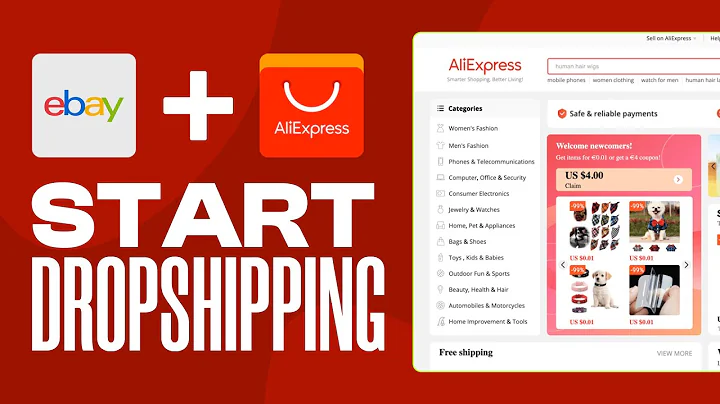Step-by-Step Guide: Start a Profitable Dropshipping Business Today
Table of Contents
- Introduction
- What is dropshipping?
- Why Dropshipping is a Popular Business Model
- Pros and Cons of Dropshipping
- Getting Started with Dropshipping
- Setting up a WordPress Website
- Installing the Astra Theme
- Installing the WooCommerce Plugin
- Installing the Elementor Pro Plugin
- Installing the dropship Me Plugin
- Selecting and Importing Products
- Configuring WooCommerce Settings
- Payment Methods
- Shipping Settings
- Creating a Unique Selling Proposition (USP)
- Creating Custom Pages with Elementor
- Writing Persuasive Product Descriptions
- Adding Videos and Imagery to Enhance Product Listings
- Marketing and Promoting Your Dropshipping Business
- Creating an Effective Marketing Funnel
- Leveraging Social Media Advertising
- Email Marketing Strategies
- Influencer Partnerships
- Conclusion
How to Start a Profitable Dropshipping Business for Beginners
Dropshipping has gained a lot of attention in recent years as a popular and lucrative way to make money online. With the right attitude and a well-planned strategy, dropshipping can become a successful e-commerce venture. In this article, we will guide you step-by-step on how to start your own profitable dropshipping business.
1. Introduction
In this competitive world of online marketing, there are two bright prospects that stand out - affiliate marketing and e-commerce. While both offer great potential for financial success, dropshipping, in particular, has emerged as a top choice for many entrepreneurs, enabling them to earn six to seven-figure incomes.
2. What is Dropshipping?
Dropshipping is a business model where you sell products to customers without having to hold any inventory. Instead, when a customer places an order on your online store, you simply purchase the product from a third-party supplier who then ships it directly to the customer. This means you don't have to worry about storing, packaging, or shipping products yourself.
3. Why Dropshipping is a Popular Business Model
Dropshipping offers several advantages that make it an attractive business model. Firstly, it requires minimal startup costs compared to traditional retail business models. You don't need to invest in inventory or a physical store, which significantly reduces your initial financial risk.
Additionally, dropshipping allows you to offer a wide variety of products without the constraints of inventory storage. You can easily expand and test different product lines to see what resonates with your target audience, providing you with more flexibility and market responsiveness.
4. Pros and Cons of Dropshipping
Like any business model, dropshipping has its own set of pros and cons. Let's explore them:
Pros of Dropshipping:
- Low startup costs: You only need a computer and an internet connection to get started.
- Minimal risk: With no inventory to manage, you won't be stuck with unsold products.
- Flexibility and scalability: Easily add or remove products from your store as per market demand.
- Location independence: Run your business from anywhere in the world as long as you have an internet connection.
- Wide product selection: Access to a vast range of products from various suppliers without needing a physical inventory.
Cons of Dropshipping:
- Lower profit margins: Since you're not buying products in bulk, your profit margins might be lower.
- Reliance on suppliers: Your reputation depends on the quality and reliability of your suppliers.
- Inventory mistakes: Suppliers might sell out of a product before updating their inventory, potentially leading to order cancellations.
- Shipping times and costs: Delays in shipping or high shipping costs can affect customer satisfaction.
- Increased competition: Dropshipping is a popular business model, so you'll face competition from other sellers.
5. Getting Started with Dropshipping
To start your dropshipping business, you'll need to follow a few essential steps. Let's dive into each of them:
5.1 Setting up a WordPress Website
The first step in launching your dropshipping business is setting up a website. WordPress is a popular content management system that is easy to use and highly customizable. It allows you to create a professional-looking online store without any coding skills.
5.2 Installing the Astra Theme
The Astra theme is a lightweight and highly customizable WordPress theme specifically designed for e-commerce. It offers various features and templates that cater to the needs of an online store. Install and activate this theme to give your store a visually appealing look.
5.3 Installing the WooCommerce Plugin
WooCommerce is a powerful and free e-commerce plugin for WordPress. It provides all the necessary tools to manage your online store efficiently. Install and activate the WooCommerce plugin to start selling products on your website.
5.4 Installing the Elementor Pro Plugin
Elementor is a popular drag-and-drop website builder that allows you to create stunning web pages without any coding. The Pro version of Elementor offers additional features like a theme builder and pop-up builder, enabling you to design unique and conversion-focused landing pages.
5.5 Installing the Dropship Me Plugin
The Dropship Me plugin simplifies the process of finding and importing high-quality products into your store. It provides a curated list of best-selling products from AliExpress, one of the world's leading dropshipping platforms. Install and activate this plugin to easily import products with just a few clicks.
6. Selecting and Importing Products
After installing the necessary plugins, it's time to select the products you want to sell on your store. Dropship Me offers a wide range of categories to choose from. When selecting products, consider factors such as the product's rating, the number of orders, and the profit margin. Import the chosen products to your store using the Dropship Me plugin.
7. Configuring WooCommerce Settings
To ensure a smooth buying experience for your customers, configure the settings in WooCommerce. Set up payment methods, such as PayPal or Stripe, to securely process transactions. Additionally, set up shipping settings and enable free shipping, if possible, to attract more customers.
8. Creating a Unique Selling Proposition (USP)
To stand out in the competitive e-commerce market, it's important to create a unique selling proposition (USP). This involves creating custom pages using Elementor, writing persuasive product descriptions, and incorporating videos and imagery to enhance your product listings. Offer a personalized and engaging experience to attract customers and differentiate yourself from competitors.
9. Marketing and Promoting Your Dropshipping Business
Having a well-designed and functional store is just the first step. To drive traffic and generate sales, you need to implement effective marketing strategies. These can include creating an effective marketing funnel, leveraging social media advertising, implementing email marketing strategies, and exploring influencer partnerships.
10. Conclusion
Starting a profitable dropshipping business requires careful planning, strategy, and continuous marketing efforts. By following the steps mentioned in this article and implementing effective marketing techniques, you can build a successful and lucrative dropshipping business. Remember to stay updated with the latest trends and continuously improve your store to meet customer needs and expectations.



















